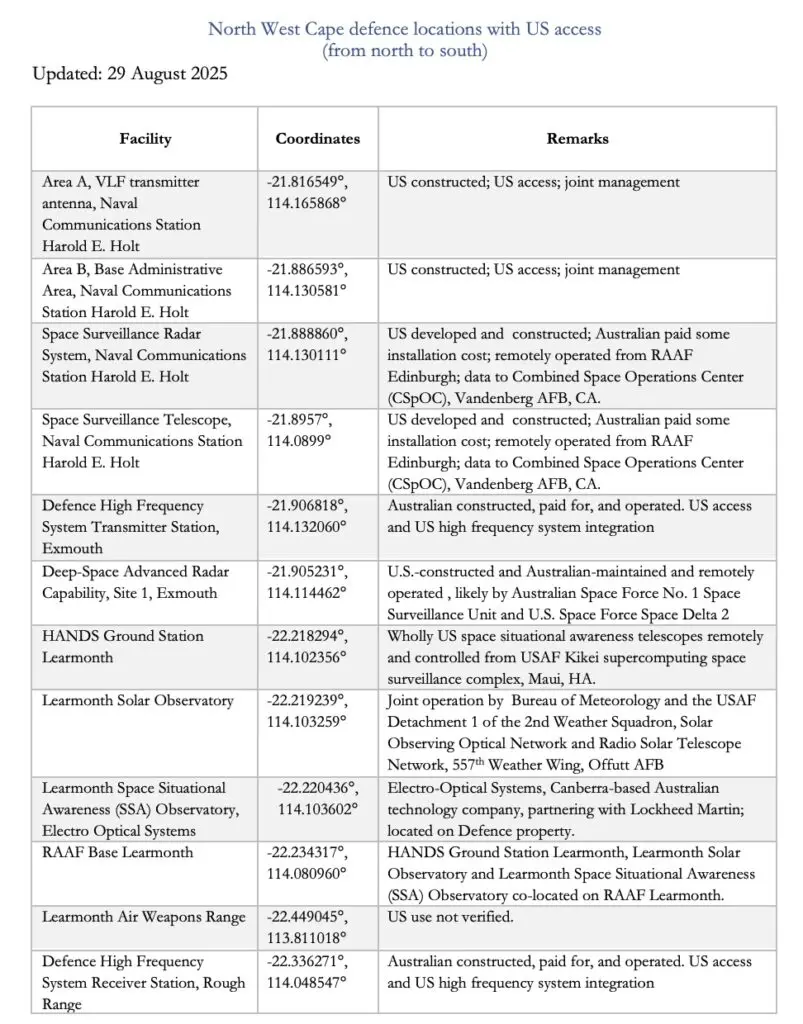The North West Cape cluster of
high technology defence facilities
Deepening US access to more Australian military and intelligence bases
In recent years successive Australian governments have been insistent on the joint character of any cooperative activity within Australia with US military forces and intelligence agencies. For example, the ratification of the 2008 treaty concerning US access to the once again joint North West Cape facility confirmed that the treaty ‘includes a requirement that U.S. use of the Station be in accordance with the Australian Government’s policy of full knowledge and concurrence.’[1]
Another Australian government mantra, usually from the Defence Minister, has been that ‘There are no US bases in this country.’ This is not correct. This is not just a politician being economical with the truth, but in fact a complete misrepresentation of strategic reality, which is in fact one of fundamental and inherent asymmetrical cooperation between the United States and Australia.
Of course, there are differences of degree as to which military and intelligence bases on Australian soil can be appropriately regarded as ‘joint facilities. If you like, there are degrees of ‘jointness’. The Australian government has only specifically identified three bases as joint facilities: the Joint Defence Facility Pine Gap, the US Air Force operated nuclear detonation seismic monitoring network at the Joint Geological and Geophysical Research Station, and the HANDS (High Accuracy Network Determination System) Ground Station Learmonth on North West Cape. The Australian government has never provided a full and accurate list of joint facilities, but the statements identifying the three just mentioned imply that there are others, as is certainly the case.
In part, this is a matter of in what sense they are joint.[2] Regarding the major actual joint facilities such as Pine Gap and North West Cape and the recent extensions to the Australian Defence Satellite Communications Station at Kojarena near Geraldton. If the facility was built by the United states, paid for by the United States, and can only operate effectively as part of the US globally distributed technological system, then it is best to regard those as US facilities to which Australia has a greater or lesser degree of access.
However, in understanding the relationship between the US alliance and military and intelligence facilities in Australia, it may be misleading to concentrate only on these well-known examples. In a recent survey, US military and intelligence agencies have been found to have access to more than fifty Australian defence facilities. In some cases, this access was relatively minor, but in most cases it was considerable.
This represents a shift back to the situation from the 1950s to the 1970s when, as Desmond Ball documented in A Suitable Piece of Real Estate: American Installations in Australia, there were a large number of little-known US facilities in Australia. Over time, many of those were closed as US requirements changed. That situation has now changed again.
The clusters of Australian defence facilities on the Exmouth Peninsula typify these developments, as listed in the table below, arranged from north to south, including
- Naval Communication Station Harold E. Holt (North West Cape)
- Space Surveillance Radar, Exmouth
- Space Surveillance Telescope, Exmouth
- Deep-Space Advanced Radar Capability, Site 1, Exmouth, Western Australia
-
Defence High Frequency System Transmitter and Receiving Stations, Exmouth and Rough Range
- Learmonth Solar Observatory
- Extended HANDS facility, Exmouth
- Learmonth Space Situational Awareness (SSA) Observatory, Electro Optical Systems/Lockheed Martin
The North West Cape cluster
One example is the high technology cluster of facilities to which all but one of which the US has access on the Exmouth Peninsula and North West Cape. Most of these facilities are longstanding, with US access reaching back to the early 1960s. The Space Surveillance Radar and Space Surveillance Telescope have only recently been constructed, with both operating under the control of Space Surveillance Unit No. 1 (SSU 1) at RAAF Base Edinburgh near Adelaide.
But both supply space situational data and space object identification on satellites and on space debris to Combined Space Operations (CSpOC), under the United States Space Command’s Combined Force Space Component Command.
The Deep-Space Advanced Radar Capability, Site 1, Exmouth at which initial testing commenced in mid-2025 is likely to be operated remotely under the control of Space Surveillance Unit No. 1 (SSU 1) at RAAF Base Edinburgh near Adelaide.
Some are huge facilities like the VLF transmitter; the HANDS Ground Station Learmonth is the size of a house block.
In some cases, US access is total; in others substantively joint, and in other cases still Australian constructed and operated facilities, such as the Defence High Frequency System Stations, collaborate closely with their US equivalents, and are in important respects closely integrated, with access for US personnel.
[1] Australia-United States Exchange of Letters Relating to Harold E. Holt Naval Communications Station, AUSMIN 2010, Department of Foreign of Affairs and Trade. One of the best discussion of ‘Full Knowledge and Concurrence’ is in Graeme Dobell, ‘Australia-East Asia/US Relations: Election plus Marines, Joint Facilities and the Asian Century’, Comparative Connections, September 2013, at http://cc.pacforum.org/2013/09/election-plus-marines-joint-facilities-asian-century/.
[2] For an important discussion of the bases, see Felicity Ruby, ‘Silent partners: US bases in Australia’, Australian Foreign Affairs, 8 (February 2020).



As a US Naval officer when I was an Ensign and then Ltjg I was assigned as a NAVCOM watch stander in the main Comms building. We communicated with Navcom stations-US and Australian- throughout the world and we backed up the comms coming from the Vietnam conflict. I experienced a change of scenery since I traveled from the United Stats (Louisiana) where I was living in a semi-swamp like area outside of New Orleans with my mother and father. At Exmouth Communication station we were communicating and supporting our Vietnamese troops and were proud supporting them.